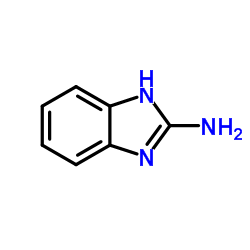Experimental and theoretical (DFT) characterization of the excited states and N-centered radical species derived from 2-aminobenzimidazole, the core substructure of a family of bioactive compounds.
Verónica Viudes, Pavel Bartovský, Luis R Domingo, Rosa Tormos, Miguel A Miranda
Index: J. Phys. Chem. B 114(19) , 6608-13, (2010)
Full Text: HTML
Abstract
Fluorescence spectroscopy, laser flash photolysis (LFP), and density functional theory (DFT) calculations have been performed to understand the photobehavior of 2-aminobenzimidazole (1). The emission lifetime and quantum yield are solvent-dependent. Direct LFP of 1 at 266 nm in MeCN solution results in the generation of a transient identified as radical 1(-H)(*) by comparison with the species generated upon tert-butyl peroxide (ROOR) irradiation in the presence of 1. In addition, a transient assigned as the triplet state is detected in MeOH solution. Theoretical DFT studies on the hydrogen abstraction process support formation of a 1...OR complex, which undergoes nitrogen to oxygen hydrogen transfer, producing the above-mentioned 1(-H)(*) radicals.
Related Compounds
| Structure | Name/CAS No. | Molecular Formula | Articles |
|---|---|---|---|
 |
2-Aminobenzimidazole
CAS:934-32-7 |
C7H7N3 |
|
Aggregation of 2-aminobenzimidazole--a combined experimental...
2011-06-20 [ChemPhysChem 12(9) , 1747-55, (2011)] |
|
Brain-penetrating 2-aminobenzimidazole H(1)-antihistamines f...
2009-08-01 [Bioorg. Med. Chem. Lett. 19(15) , 4380-4, (2009)] |
|
Chemical biology strategy reveals pathway-selective inhibito...
2010-03-19 [ACS Chem. Biol. 5 , 287-299, (2010)] |
|
Identification of 2-aminobenzimidazoles as potent melanin-co...
2009-07-01 [Bioorg. Med. Chem. Lett. 19(13) , 3568-72, (2009)] |
|
Synthesis and QSAR studies of novel 1-substituted-2-aminoben...
2006-09-01 [Eur. J. Med. Chem. 41(9) , 1080-3, (2006)] |